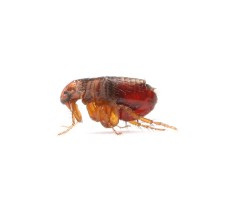
The cat flea is approximately 2 mm long, reddish brown in colour and is flattened laterally, a feature which enables it to move easily in the hair of its host. The most distinctive features of the cat flea are the large jumping legs and the row of black non-sensory spines on the front of the head and on the rear of the first thoracic segment. The eyes are evident, as are the antennae and the mouthparts which are adapted for piercing and sucking.
Where will you find them?
Although the cat and the dog are the preferred hosts for cat fleas they are also capable of feeding on humans. The discomfort caused by flea bites can be significant in cats and humans.
How do we control fleas?
Treatment consists of identifying the source of the infestation, i.e.: the host animal, and if appropriate, treating it with a suitable veterinary product – this treatment is not be carried out by the pest control technician but by the owner of the animal or a veterinarian.
A residual insecticide should then be applied to areas visited by the animal. Normally this would consist of spraying all areas in the premises as a precaution. Once the first visit is complete our technician would complete a detailed inspection report explaining what he has done. Once our work is completed our technician will fill out a detailed inspection report and discuss ways of preventing re-infestation.
Follow up visits
We would need to carry out two follow up visits for fleas between 7-10 days apart, the premises are treated in exactly the same way as the initial visit. Once our work is completed our technician will fill out a detailed inspection report and discuss ways of preventing re-infestation.
